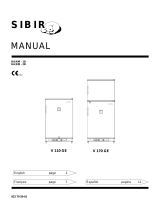La plaque signalétique (voir à l'intérieur de l'appareil) renseigne sur la pression
d'alimentation en gaz recommandée exprimée en mbar (norme de pression en
Allemagne, en Autriche et en Suisse). L'appareil ne peut fonctionner sous une
pression autre que celle indiquée sur la plaque signalétique. Il est recommandé
d'utiliser un régulateur de pression adéquat.
9. Raccordement à la bouteille de gaz (fig. 6, 7)
Le raccordement du réfrigérateur doit être fait par un spécialiste qualifié.
Il faut respecter les normes nationales en vigueur, relatives à l'utilisation
des appareils fonctionnant avec du gaz liquide.
Raccordez le mobilCooler dans l'ordre suivant:
bouteille à gaz
→→
détendeur
→→
appareil
La tubulure de raccordement au gaz (D) à l'arrière de l'appareil est conçu pour
être raccordé a un tuyau souple butane-propane normalisé NF.
Les prescriptions de sécurité interdisent formellement de rechercher des fuites
aux raccords d'appareil et installations à l'aide d'eau mousseuse ou d'une
bombe «détecteur de fuites» mousseuse. Cette prescription s'applique à toutes
sortes de gaz en bouteille et de gaz liquéfiés.
La prescription recommande donc d'enduire les parties à examiner avec des
produits moussants tels que produits de rinçage, savon liquide etc. Pour votre
sécurité personnelle, tous les éléments sous pression de gaz et, en particulier
les raccords à vis doivent être contrôlés de la façon prescrite.
IL EST INTERDIT DE CONTROLER L'ETANCHEITE A LA FLAMME!
NE PAS FUMER! DANGER D'EXPLOSION ET DE BRULURE!
Fermer impérativement le robinet de la bouteille de gaz ou le robinet de
détendeur au moment de l'échange de la bouteille de gaz et/ou du démontage
du tuyau souple.
Remplacer le tuyau souple s'il est endommagé ou s'il devient poreux.
10. Robinetterie gaz (fig.1)
L'appareil est équipé d'un bouton thermostat (C) gaz/éléctricité, un contrôle de
sécurité intégré, un dispositif d'allumage de piezo (Figure 6) (D) ou allumage
électronique (Figure 7) (E), et un galvanomètre (B).
La veilleuse de sécurité maintient automatiquement l'alimentation du brûleur en
gaz aussi longtemps que la flamme brûle; elle stoppe automatiquement
l'alimentation en gaz si la flamme s'éteint.
11. Allumage du brûleur au gaz (fig. 5, 6, 7)
1. Mettre le sélecteur d'énergie (A) à la position 'Gaz'.
2. Ouvrez la bouteille de gaz et la vanne régulatrice de pression
3. Tournez le thermostat gaz/électricité (C) jusqu'à la position MAX et tenez
appuyé le bouton.
20
F





















